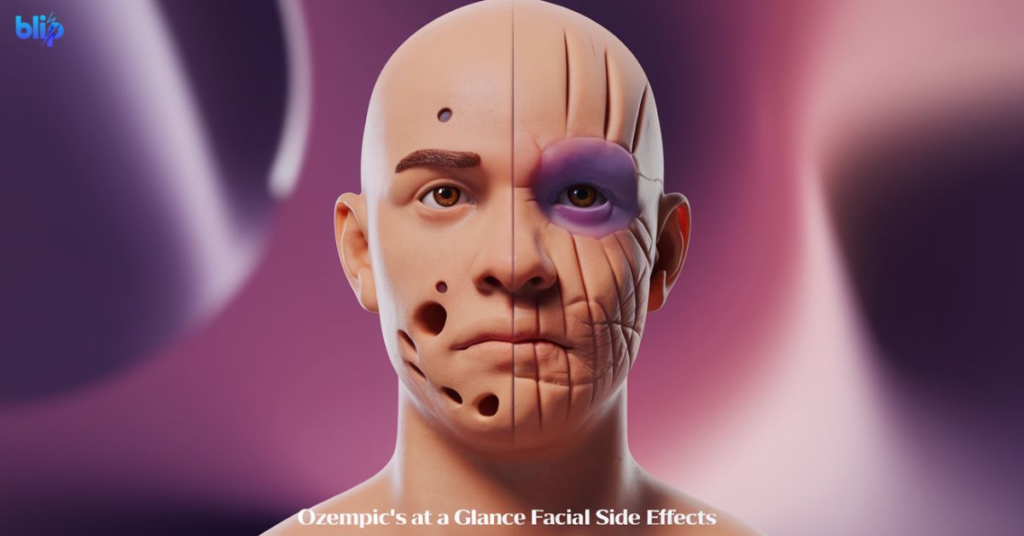Ozempic is a medication used to treat type 2 diabetes. Some people who take Ozempic have reported a concerning side effect known as “Ozempic face” – a loss of facial fat that can lead to a more sunken or gaunt appearance.
Ozempic’s mechanism of action, which helps regulate appetite and blood sugar levels, can also induce rapid weight loss. This dramatic fat loss, including from the face, is believed to be the primary cause of Ozempic face. Factors like lower starting body fat and older age may increase the risk.
In addition to Ozempic face, other potential side effects of the medication include nausea, diarrhea, vomiting, and an increased risk of pancreatitis. Some research has also suggested a possible link between Ozempic and thyroid cancer, though the evidence is still limited.
How does Ozempic affect the face?
Ozempic’s ability to regulate appetite and slow gastric emptying can lead to a significant calorie deficit and dramatic fat loss throughout the body, including the face. This loss of facial volume is what gives rise to the “Ozempic face” appearance.
The exact reasons why some individuals experience more pronounced facial fat loss than others are not yet fully understood. However, factors like a person’s existing body composition and age seem to play a role in the likelihood and severity of Ozempic face.
Facial fat loss can be a visible and potentially distressing side effect for those taking Ozempic. The changes to one’s appearance can impact self-confidence, social interactions, and even the practical aspects of daily life, such as the fit of eyeglasses or the need to adjust skincare routines.
Other possible side effects of Ozempic
In addition to Ozempic face, the medication can also cause other common side effects, such as nausea, diarrhea, and vomiting. There have also been some concerns raised about a potential link between Ozempic use and an increased risk of pancreatitis or thyroid cancer, though the evidence is still limited.
Individuals taking Ozempic should be aware of these potential side effects and monitor their health closely. Reporting any concerning symptoms to their healthcare provider is crucial for managing the risks associated with the medication.
Maintaining open communication with one’s doctor is particularly important, as they can help determine if adjustments to the Ozempic dosage or consideration of alternative treatments may be appropriate.
Preventing facial side effects

To help mitigate the facial side effects of Ozempic, such as volume loss and skin changes, there are several strategies individuals can consider:
- Maintaining a balanced, protein-rich diet: Ensuring adequate nutrient intake can support skin health and collagen production, which may help offset some of the facial fat loss.
- Incorporating targeted skin care: Using products containing ingredients like retinoids, vitamin C, and hyaluronic acid can help improve skin texture, tone, and elasticity.
- Engaging in regular exercise: Physical activity, particularly resistance training, can help preserve muscle mass and support overall body composition, which may have a positive impact on facial appearance.
- Exploring cosmetic treatments: Procedures like dermal fillers or fat grafting can help restore lost facial volume and improve the appearance of Ozempic face.
While these strategies may not completely prevent or reverse the facial changes associated with Ozempic, they can help manage the side effects and maintain a more youthful, vibrant appearance.
What happens after stopping Ozempic?
The facial fat loss linked to Ozempic is typically reversible. After discontinuing the medication, patients have reported a gradual return of facial volume over time.
However, the timeline for this reversal can vary, and some individuals may require additional interventions, such as cosmetic treatments, to fully address the effects of Ozempic face.
It’s important to note that the specific duration and extent of facial changes can differ from person to person, depending on factors like the length of Ozempic use, the individual’s starting body composition, and their response to the medication.
When to contact a doctor
If you are experiencing significant facial changes or other concerning side effects while taking Ozempic, it’s crucial to discuss them with your healthcare provider.
Your doctor can help determine the best course of action, which may include adjusting the Ozempic dosage, considering alternative diabetes medications, or exploring options for addressing the cosmetic effects of Ozempic face.
Prompt communication with your healthcare team is essential, as they can provide personalized guidance and support to help you manage the potential side effects of Ozempic and maintain your overall health and well-being.
Ozempic’s At a Glance Facial Side Effects

| Effect | Description |
| Increased Wrinkles | Ozempic’s rapid weight loss can lead to a loss of facial fat, resulting in more pronounced lines and wrinkles. |
| Hollow Cheeks | The reduction in facial volume can create a sunken, hollowed-out appearance, particularly in the cheek area. |
| Sagging Skin | Without the underlying fat to provide structure and support, the skin on the face can begin to sag and lose its youthful firmness. |
| Gaunt Appearance | The combination of facial fat loss and skin changes can contribute to an overall aged, gaunt look. |
| Impact on Daily Life | The dramatic changes in facial appearance can affect self-confidence, social interactions, and even practical aspects of daily living. |
This table provides a concise overview of the key facial side effects associated with the use of Ozempic, a medication primarily prescribed for the treatment of type 2 diabetes. Understanding these potential changes is crucial for those considering or currently taking Ozempic, as they can have a significant impact on one’s appearance and quality of life.
Read this Blog: Ideal weight : How Much Should I Weigh for My Height and Age?
Other Potential Side Effects of Ozempic
In addition to “Ozempic face,” the medication can also cause other common side effects, such as nausea, diarrhea, and vomiting. There have also been concerns raised about a potential link between Ozempic use and an increased risk of pancreatitis or thyroid cancer, though the evidence is still limited.
Individuals taking Ozempic should be aware of these potential side effects and monitor their health closely. Reporting any concerning symptoms to their healthcare provider is crucial for managing the risks associated with the medication.
Open communication with one’s doctor can help determine if adjustments to the Ozempic dosage or consideration of alternative treatments may be appropriate.
Reversing the Effects of “Ozempic Face”

The facial fat loss linked to Ozempic is typically reversible. After discontinuing the medication, patients have reported a gradual return of facial volume over time.
The timeline for this reversal can vary, and some individuals may require additional interventions, such as cosmetic treatments, to fully address the effects of “Ozempic face.”
The specific duration and extent of facial changes can differ from person to person, depending on factors like the length of Ozempic use, the individual’s starting body composition, and their response to the medication.
It’s important to note that it can take around 5 weeks for Ozempic to fully clear the body after the last dose, so some side effects may persist temporarily during this transition period.
Final Words
The emergence of “Ozempic face” has brought to light the significant cosmetic impacts that this diabetes medication can have. The rapid weight loss induced by Ozempic can lead to a noticeable loss of facial fat, resulting in a more aged, sunken, or gaunt appearance.
While Ozempic can be an effective treatment for managing type 2 diabetes, it’s important for patients to be aware of the potential facial side effects. Strategies like dosage adjustments, switching medications, and incorporating lifestyle changes may help mitigate the severity of these changes. Cosmetic treatments can also be explored to address the visual effects of “Ozempic face.”
As the use of Ozempic continues to grow, both for diabetes management and off-label weight loss, understanding and managing the associated facial side effects will remain an important consideration. Maintaining open communication with healthcare providers is crucial, as they can offer personalized guidance and support to help patients navigate the challenges of “Ozempic face” and prioritize their overall health and well-being.
Frequently Asked Questions
Does Ozempic change your face?
Yes, Ozempic can cause noticeable facial changes.
What does an Ozempic face look like?
More wrinkles, sagging skin, and a hollow, gaunt appearance.
Does Ozempic age your skin and face?
Yes, rapid weight loss can accelerate signs of facial aging.
Can “Ozempic face” be prevented?
Strategies like dosage adjustments and cosmetic treatments may help.
What happens if you stop taking Ozempic?
Facial changes may gradually reverse, but weight regain is common.

Zade Smith is a Proficient writer on TechsBlip, dedicated to delivering high-quality content that bridges the gap between medical research and accessible, reader-friendly guidance. With a keen interest in promoting healthy lifestyles and disease prevention, Zade’s writing offers expert insights, actionable tips, and evidence-based information to help readers make informed decisions about their health and wellness

